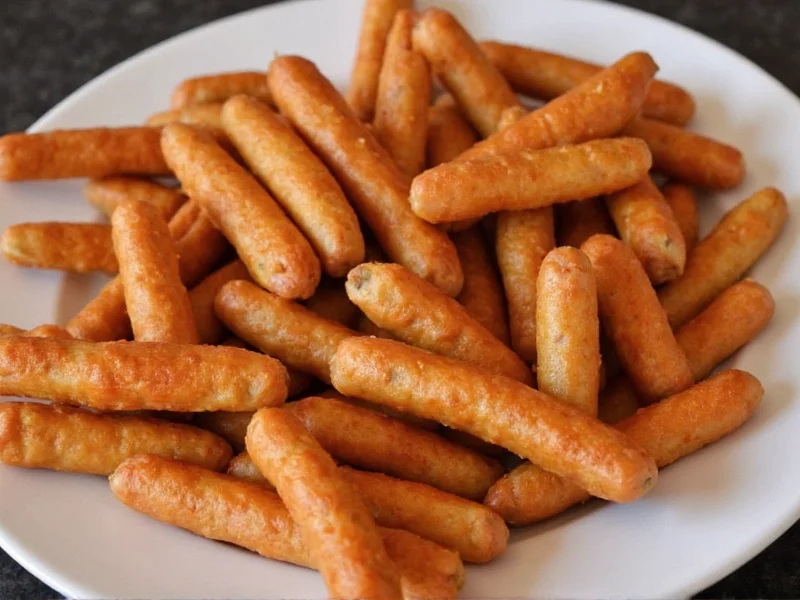Maple sausage links represent a beloved North American breakfast tradition that perfectly balances sweet and savory flavors. These small, linked pork sausages incorporate maple syrup or maple flavoring into their seasoning blend, creating a distinctive taste profile that has made them a staple in diners and home kitchens across Canada and the northeastern United States.
What Makes Maple Sausage Links Unique
Unlike regular breakfast sausage, maple sausage links contain natural or artificial maple flavoring along with other seasonings like sage, thyme, and black pepper. The maple component typically comes from real maple syrup, maple sugar, or concentrated maple flavor. This sweet element complements the savory pork base, creating a complex flavor profile that works exceptionally well with traditional breakfast foods like pancakes, eggs, and toast.
The texture of quality maple sausage links should be firm but not tough, with visible flecks of seasoning throughout. When cooked properly, they develop a beautifully caramelized exterior while maintaining a moist, flavorful interior. The best products use high-quality pork with a good fat-to-lean ratio (typically 70-80% lean meat) to ensure juiciness after cooking.
Ingredients and Variations
Traditional maple sausage links contain:
- Pork (usually shoulder or belly for optimal fat content)
- Maple syrup or maple flavoring
- Salt and pepper
- Sage, thyme, and other herbs
- Spices like nutmeg or red pepper flakes
- Preservatives like sodium nitrite (in most commercial varieties)
Several variations exist in the marketplace:
| Variation | Key Characteristics | Best Cooking Method |
|---|---|---|
| Traditional Pork | Classic maple flavor with 70-80% lean pork | Pan-frying or baking |
| Chicken/Turkey | Lighter protein option with similar maple sweetness | Baking to prevent drying |
| Maple-Apple | dAdditional apple flavor complements the maple | Pan-frying for caramelization |
| Sugar-Free | Uses sugar substitutes while maintaining maple flavor | Grilling or air frying |
Proper Cooking Techniques for Maple Sausage Links
Mastering how to cook maple sausage links properly ensures optimal flavor and texture. The best methods include:
Pan-Frying Method
This traditional approach creates a beautifully caramelized exterior. Place links in a cold skillet, then turn heat to medium. Cook for 12-15 minutes, turning occasionally, until internal temperature reaches 160°F (71°C). The gradual heating prevents the casing from splitting while allowing fat to render slowly.
Baking Method
For hands-off cooking, arrange links on a parchment-lined baking sheet. Bake at 375°F (190°C) for 20-25 minutes until golden brown and cooked through. This method produces evenly cooked sausage with less hands-on attention required.
Air Frying Method
Modern air fryers work exceptionally well for maple sausage links. Cook at 360°F (182°C) for 10-12 minutes, shaking the basket halfway through. This technique creates a crispy exterior while preserving moisture inside.
Regardless of method, never pierce the sausages while cooking, as this releases precious juices. Always verify doneness with a meat thermometer rather than cutting into them, which also causes moisture loss.
Storage and Shelf Life Guidelines
Understanding proper storage for maple sausage links ensures food safety and maintains quality:
- Refrigerated raw links: Consume within 1-2 days of purchase or by the "use by" date
- Freezing: Wrap tightly in freezer paper or place in airtight containers; maintains quality for 2-3 months
- Cooked leftovers: Store in airtight container for up to 4 days in refrigerator
- Never thaw sausage links at room temperature; use refrigerator thawing instead
Nutritional Profile and Dietary Considerations
A typical serving (2 links, approximately 85g) of maple sausage links contains:
- Calories: 250-300
- Protein: 12-15g
- Total fat: 20-25g (including 7-9g saturated fat)
- Carbohydrates: 2-4g (primarily from maple syrup)
- Sodium: 500-700mg
For those monitoring sodium intake, look for reduced-sodium varieties. Many brands now offer options with natural ingredients and no artificial preservatives. When incorporating maple sausage links into a balanced breakfast, pair them with protein-rich eggs and fiber-filled whole grains to create a more nutritionally complete meal.
Creative Recipe Ideas Beyond Breakfast
While maple sausage links shine at breakfast, they offer versatility across multiple meals:
- Maple Sausage Breakfast Casserole: Combine cooked links with eggs, cheese, and potatoes for a hearty brunch dish
- Sausage and Apple Skillet: Pan-fry links with sliced apples and onions for a sweet-savory side
- Maple Sausage Pizza: Use crumbled cooked links as a topping with caramelized onions and sharp cheddar
- Sausage-Stuffed Sweet Potatoes: Top baked sweet potatoes with sliced maple sausage and a dollop of Greek yogurt
For meal prep enthusiasts, cooking a batch of maple sausage links at the beginning of the week provides ready-to-use protein for quick breakfasts or lunches throughout the week. Simply store in the refrigerator and reheat in a skillet or microwave when needed.
Common Questions About Maple Sausage Links
Understanding proper preparation techniques significantly impacts the final result when cooking maple breakfast sausage. Many home cooks wonder about the best way to prepare maple sausage without compromising texture or flavor. The key lies in controlled, gradual cooking that allows fat to render properly while developing that desirable caramelized exterior.











 浙公网安备
33010002000092号
浙公网安备
33010002000092号 浙B2-20120091-4
浙B2-20120091-4